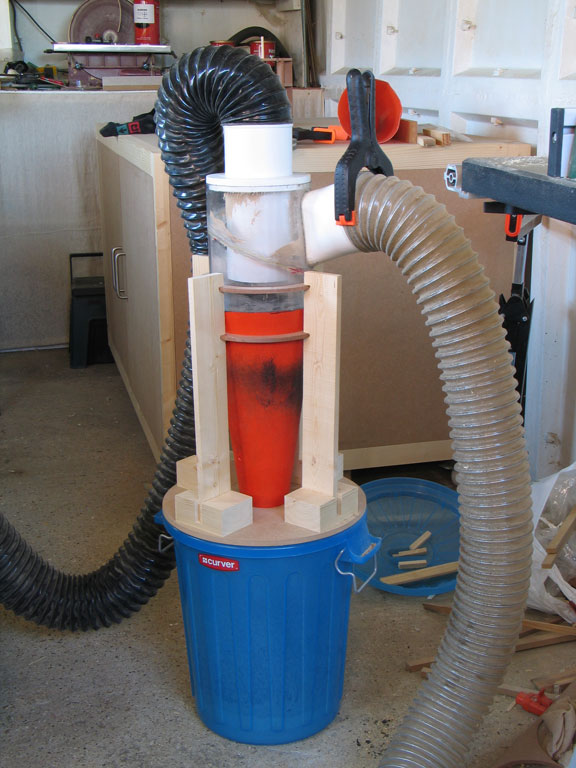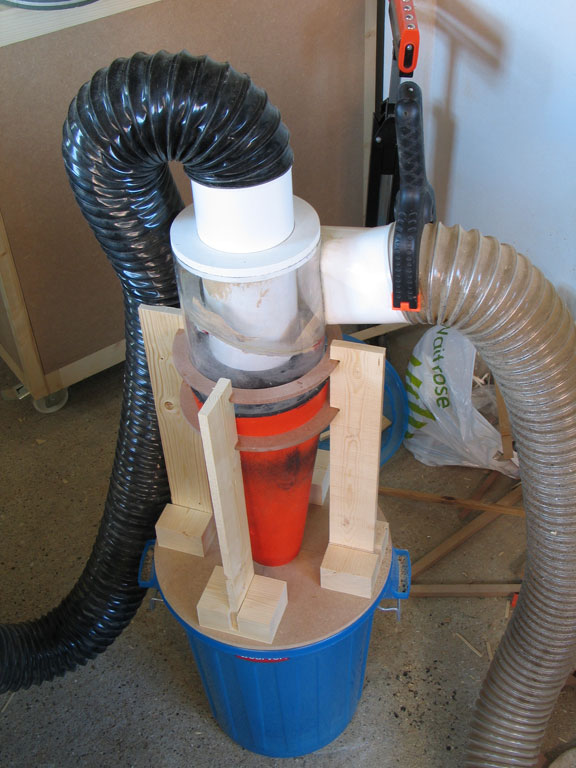AES
Established Member
G'morning all,
I have quite a dust collection problem in my cellar/workshop, as it’s (obviously!) part of the house and most important, it’s shared with “ ‘er upstairs”.
A recent post in the Scroll Sawing section here drifted quite a bit off topic (“Guilty as charged m' Lud”), showing what I thought was a good idea by using a rainwater hopper-type collector as a dust collector hood (pages 4 & 5 of the link below refers).
my-new-hegner-workshop-tidy-up-t87357.html
I couldn’t find a hopper in my local DIY emporium, but did find a big plastic funnel, which after some bodging around with bits & pieces of plastic pipes & fittings and self tappers plus bathroom silicon sealant has morphed into this:

If it’s important, the OD of the funnel is approx 9.5 inches, height of the conical section approx 6 inches, and overall height is about 18 inches.

I’ve paid careful attention to making the internal connection joints as smooth as possible, and the internal pipe diameters reduce quite gently from 75 mm at the top of the conical section to 50 mm at the top end shown (which couples nicely onto the shop vac flexible hose, with the help of the hose clamp shown). As seen, there is only one bend of about 45 degrees.
The shop vac is a Karcher wet/dry model A2654 rated at 1800 watts. In “normal use” it sucks like a good ‘un and was superb at sucking up water when we had a cellar flood last year – through it’s normal 50 mm flex hose I stress.
As the first experiment I used a piece of thick obechi scrap, shaping it against a 60 grit disc on the small (5 inch) disc/belt sander shown below.

While I sanded the scrap my wife held the funnel close to the disc at the area where some/most of the dust was appearing, with the vac running of course. We could see that some of the obechi dust was definitely being sucked into the funnel but at a guess it was less than 50% of the total dust produced – my wife remarked “that’s not exactly the full yoke of the egg dear”! And in the pic you can see quite a lot of dust residue still adhering to the sander.
I should also add that before this test the vac filter was cleaned and a new (empty) paper bag fitted. (When I can get this set up to work OK I’m going to make a Thein or cyclone separator, plus add a quieter vac).
So what now please?
Is it “just” a question of a more powerful vacuum? (The Karcher is pretty good at sucking but is VERY loud – I can’t hear the phone in the cellar ring when the vac’s running).
Bigger funnel?
Smaller funnel (the one shown is just about as small as is convenient when trying to work with the sander shown and would definitely be too small to cover the other disc/belt sander I have)?
Bigger diameter pipe work?
Now I’m going to rig up some thin sheet metal “vortex generators” about 1 inch high and a bit curved/angled, then silicon them into the inner part of the cone (to try and induce turbulence, so – hopefully - increasing the suction effect). I’m by no means an aerodynamicist but do understand the very basics. I’ll just set them at about 15 degrees to the flow at the top of the cone, changing to about 30 degrees at the bottom. I’ve no idea if this will help but will report the results (if anyone's interested).
Any other ideas or comments on any of the above gratefully received in the meantime.
Thanks in advance
AES
I have quite a dust collection problem in my cellar/workshop, as it’s (obviously!) part of the house and most important, it’s shared with “ ‘er upstairs”.
A recent post in the Scroll Sawing section here drifted quite a bit off topic (“Guilty as charged m' Lud”), showing what I thought was a good idea by using a rainwater hopper-type collector as a dust collector hood (pages 4 & 5 of the link below refers).
my-new-hegner-workshop-tidy-up-t87357.html
I couldn’t find a hopper in my local DIY emporium, but did find a big plastic funnel, which after some bodging around with bits & pieces of plastic pipes & fittings and self tappers plus bathroom silicon sealant has morphed into this:

If it’s important, the OD of the funnel is approx 9.5 inches, height of the conical section approx 6 inches, and overall height is about 18 inches.

I’ve paid careful attention to making the internal connection joints as smooth as possible, and the internal pipe diameters reduce quite gently from 75 mm at the top of the conical section to 50 mm at the top end shown (which couples nicely onto the shop vac flexible hose, with the help of the hose clamp shown). As seen, there is only one bend of about 45 degrees.
The shop vac is a Karcher wet/dry model A2654 rated at 1800 watts. In “normal use” it sucks like a good ‘un and was superb at sucking up water when we had a cellar flood last year – through it’s normal 50 mm flex hose I stress.
As the first experiment I used a piece of thick obechi scrap, shaping it against a 60 grit disc on the small (5 inch) disc/belt sander shown below.

While I sanded the scrap my wife held the funnel close to the disc at the area where some/most of the dust was appearing, with the vac running of course. We could see that some of the obechi dust was definitely being sucked into the funnel but at a guess it was less than 50% of the total dust produced – my wife remarked “that’s not exactly the full yoke of the egg dear”! And in the pic you can see quite a lot of dust residue still adhering to the sander.
I should also add that before this test the vac filter was cleaned and a new (empty) paper bag fitted. (When I can get this set up to work OK I’m going to make a Thein or cyclone separator, plus add a quieter vac).
So what now please?
Is it “just” a question of a more powerful vacuum? (The Karcher is pretty good at sucking but is VERY loud – I can’t hear the phone in the cellar ring when the vac’s running).
Bigger funnel?
Smaller funnel (the one shown is just about as small as is convenient when trying to work with the sander shown and would definitely be too small to cover the other disc/belt sander I have)?
Bigger diameter pipe work?
Now I’m going to rig up some thin sheet metal “vortex generators” about 1 inch high and a bit curved/angled, then silicon them into the inner part of the cone (to try and induce turbulence, so – hopefully - increasing the suction effect). I’m by no means an aerodynamicist but do understand the very basics. I’ll just set them at about 15 degrees to the flow at the top of the cone, changing to about 30 degrees at the bottom. I’ve no idea if this will help but will report the results (if anyone's interested).
Any other ideas or comments on any of the above gratefully received in the meantime.
Thanks in advance
AES











 .... Linky Pic.
.... Linky Pic.






























